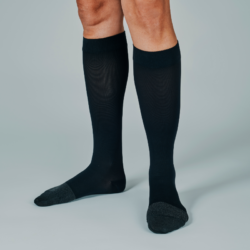Daflon is a medicine renowned for its beneficial action on the vascular system, particularly in the treatment of venous circulation disorders. However, recent discoveries have highlighted its positive effects on the skin, attributed mainly to hesperidin, a natural flavonoid extracted from citrus fruits. Hesperidin, an essential component of Daflon, plays a major protective role for skin health, particularly by strengthening the skin barrier and protecting against external aggression.
What is Hesperidin?
Hesperidin is a bioflavonoid derived from citrus fruits, with anti-inflammatory and antioxidant properties widely recognised in vascular medicine. However, its benefits for the skin are increasingly being highlighted, particularly for its role in healing, protecting against UV rays and maintaining the homeostasis of the skin barrier.
Hesperidin also helps to reduce oxidative damage and modulates antioxidant enzymes such as superoxide dismutase and glutathione peroxidase, boosting the skin’s defensive capacity against oxidative stress and external aggression.
How does Daflon work on the skin?
The skin barrier is the first line of defence against external agents and infections. As a product containing hesperidin, Daflon improves the skin’s ability to protect itself against aggression. Topical application of hesperidin improves the regeneration of the skin barrier by stimulating the proliferation of keratinocytes, the main cells of the epidermis. This stimulation is crucial for ageing or weakened skin.
Prolonged exposure to UV rays is one of the main causes of premature skin ageing. The hesperidin present in Daflon acts by neutralising the free radicals produced by UV rays. It also helps to reduce the cellular damage associated with this exposure by activating antioxidant enzymes and modulating the skin’s inflammatory mechanisms.
Daflon may also play a role in combating skin infections thanks to the antimicrobial action of hesperidin. This flavonoid has shown inhibitory effects on certain common pathogens such as Staphylococcus aureus and Candida albicans, making Daflon a promising candidate for the prevention of superficial skin infections.
Hesperidin also accelerates wound healing by promoting the production of growth factors, such as vascular endothelial growth factor (VEGF), which stimulate tissue regeneration. This process is particularly beneficial for people suffering from slow wound healing, such as diabetics.
What are the anti-ageing properties of the hesperidin contained in Daflon?
Recent studies have demonstrated the protective effect of hesperetin, a flavonoid derived from hesperidin, in preventing skin ageing. This bioactive compound acts primarily by activating the CISD2 protein, a pro-longevity gene crucial for maintaining mitochondrial function and cellular balance (homeostasis). By activating CISD2, hesperetin helps to reduce oxidative damage and the expression of senescence markers in keratinocytes, the main cells of the epidermis.
According to the work of Shen et al (2024), hesperetin, through its action on CISD2, is able to attenuate both intrinsic ageing (age-related) and extrinsic ageing (caused by environmental factors such as UV rays). In mouse models, administration of hesperetin not only slowed natural skin ageing, but also regenerated aged skin, with results such as an increase in hair follicle density, an increase in the size of sebaceous glands and a reduction in oxidative stress. These effects are largely attributed to improved mitochondrial function, which is essential for maintaining healthy skin in the face of external aggression.
Use of hesperidin in Daflon for the skin
Daflon, and more specifically the hesperidin it contains, can be used in various areas of skin care:
- Healing: Topical application promotes rapid tissue regeneration after injury or surgery.
- Photoprotection: Regular use of creams containing hesperidin may protect the skin from the harmful effects of UV rays and slow down the photo-ageing process.
- Anti-inflammatory: By reducing inflammation, Daflon could prove effective in treating inflammatory skin conditions such as eczema and rosacea.
- Anti-ageing: Thanks to the activation of CISD2 and its antioxidant properties, Daflon could potentially reduce the signs of skin ageing and improve the quality of ageing skin.
Safety and side effects
The use of Daflon on the skin is generally well tolerated. Clinical studies have shown that topical formulations containing up to 2%hesperidin do not cause undesirable side effects in the majority of users. However, as with any new product applied to the skin, it is advisable to consult a dermatologist before use, particularly for individuals with sensitive or reactive skin.
Sources
- Rodrigues, C.V.; Pintado, M. Hesperidin from Orange Peel as a Promising Skincare Bioactive: An Overview. Int. J. Mol. Sci. 2024, 25, 1890. https://doi.org/10.3390/ijms25031890
- Shen, ZQ., Chang, CY., Yeh, CH. et al. Hesperetin activates CISD2 to attenuate senescence in human keratinocytes from an older person and rejuvenates naturally aged skin in mice. J Biomed Sci 31, 15 (2024).





